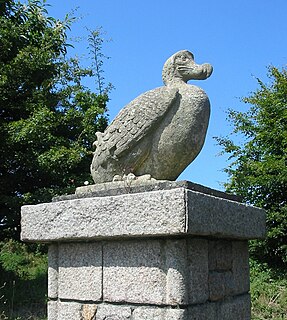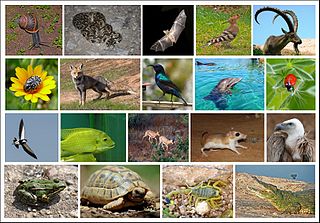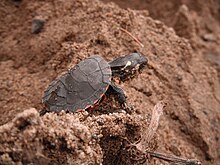
Jersey Zoo is a zoological park established in 1959 on the island of Jersey in the English Channel by naturalist and writer Gerald Durrell (1925–1995). It is operated by the Durrell Wildlife Conservation Trust. It has approximately 169,000 visitors per year; visitor numbers tend to vary with the tourist trade to Jersey.

Belize is a country with a rich variety of wildlife, due to its unique position between North and South America, and a wide range of climates and habitats for plant and animal life. Belize's low human population, and approximately 8,867 square miles (22,970 km2) of undistributed land, provides an ideal home for more than 5000 species of plants, and vast numbers species of animals — with several hundred vertebrates including armadillos, snakes, and monkeys.

The Wildlife of Costa Rica comprises all naturally occurring animals, fungi and plants that reside in this Central American country. Costa Rica supports an enormous variety of wildlife, due in large part to its geographic position between the North and South American continents, its neotropical climate, and its wide variety of habitats. Costa Rica is home to more than 500,000 species, which represents nearly 5% of the total species estimated worldwide, making Costa Rica one of the 20 countries with the highest biodiversity in the world. Of these 500,000 species, a little more than 300,000 are insects.

The fauna of the United States of America is all the animals living in the Continental United States and its surrounding seas and islands, the Hawaiian Archipelago, Alaska in the Arctic, and several island-territories in the Pacific and in the Caribbean. The U.S. has many endemic species found nowhere else on Earth. With most of the North American continent, the U.S. lies in the Nearctic, Neotropic, and Oceanic faunistic realms, and shares a great deal of its flora and fauna with the rest of the American supercontinent.

The wildlife of Israel includes the flora and fauna of Israel, which is extremely diverse due to the country's location between the temperate and the tropical zones, bordering the Mediterranean Sea in the west and the desert in the east. Species such as the Syrian brown bear and the Arabian ostrich have become extinct in Israel because of their loss of habitat. As of May 2007, 190 nature reserves have been established in Israel.

The wildlife of Algeria is composed of its flora and fauna. Mountainous, chotts, wetlands and grassy desert-like regions all support a wide range of wildlife. The most commonly seen animals include the wild boars, jackals, and gazelles, although it is not uncommon to spot fennecs and jerboas. Leopard and cheetah are seldom seen.
The natural history of Georgia covers many plant and animal species. The humid subtropical climate of Georgia influences its plant and animal life.

The fauna of Toronto include a variety of different species situated within the city limits. Toronto contains a mosaic of ecosystems that includes forests, rivers and streams, and wetlands, which allows it to support a large variety of fauna. Approximately 90 per cent of animals that inhabit the city reside within the Toronto ravine system. A number of other animals have also adapted to the Toronto's urban environment, parks, and the creeks and rivers that run throughout the city.

Pakistan's native fauna reflect its varied climatic zones.

The wildlife of Canada or biodiversity of Canada consist of over 80,000 classified species, with an equal number thought yet to be recognized. Known fauna and flora have been identified from five different kingdoms: protozoa ; chromist ; fungis ; plants ; and animals. Insects account for nearly 70 percent of recorded animal species in Canada.

The fauna of Italy comprises all the animal species inhabiting the territory of the Italian Republic and its surrounding waters. Italy has one the highest level of faunal biodiversity in Europe, with over 57,000 species recorded, representing more than a third of all European fauna. This is due to various factors. The Italian peninsula is in the center of the Mediterranean Sea, forming a corridor between central Europe and North Africa, and it has 8,000 km (5,000 mi) of coastline. Italy also receives species from the Balkans, Eurasia, and the Middle East. Italy's varied geological structure, including the Alps and the Apennines, Central Italian woodlands, and Southern Italian Garigue and Maquis shrubland, also contribute to high climate and habitat diversity.
Wyoming is home to 12 amphibian species and 22 species of reptiles.

The fauna of the State of California may be the most diverse in the United States of America. Of the Lower 48 conterminous states, California has the greatest diversity in climate, terrain and geology in general. The state's six life zones are the lower Sonoran (desert); upper Sonoran ; transition ; and the Canadian, Hudsonian, and Arctic zones, comprising California's highest elevations. California’s diverse geography gives rise to dozens of different ecosystems, each of which has its own unique native plants and animals. California is a huge state, the 3rd largest in the U.S., and can range broadly in habitat type.

The fauna of Louisiana is characterized by the region's low swamplands, bayous, creeks, woodlands, coastal marshlands and beaches, and barrier islands covering an estimated 20,000 square miles, corresponding to 40 percent of Louisiana's total land area. Southern Louisiana contains up to fifty percent of the wetlands found in the Continental United States, and are made up of countless bayous and creeks.

Missouri is home to a diversity of both flora and fauna. There is a large amount of fresh water present due to the Mississippi River, Missouri River, and Lake of the Ozarks, with numerous smaller tributary rivers, streams, and lakes. North of the Missouri River, the state is primarily rolling hills of the Great Plains, whereas south of the Missouri River, the state is dominated by the Oak-Hickory Central U.S. hardwood forest.

Florida hosts many types of fauna. From coral reefs of the Florida Keys to the cypress swamps of the Panhandle, the state's diverse habitats are home to a variety of wildlife. Florida is among the top five states in terms of endemic species. There are over 700 terrestrial animals, 200 freshwater fish species, 1,000 marine fish and thousands of terrestrial insects and other invertebrates that inhabit the state. Florida's peninsular geography spans from subtropical to tropical zones, which, combined with its distinctive geology and climate, contribute to habitat diversity and an array of species. The native wildlife that exists in the state are of temperate and tropical origin.




















